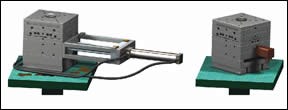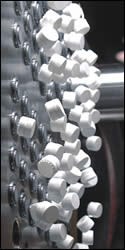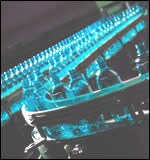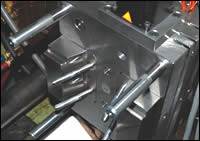New PET Bottle Standard May Boost Business for Moldmakers
A rule to lightweight preform necks and closures could require more than 1,000 new molds.
Toolmakers in North America, Europe and other areas may soon see a sharp rise in demand for injection molds. The beverage industry appears set to adopt a new neck-finish standard for carbonated soft drink (CSD) containers that will lead to a major retooling of preform and closure molds.
The standard is PCO 1881, now being finalized by the International Society of Beverage Technologists (St. Paul, MN). It seeks to reduce resin costs associated with making polyethylene terephthalate preforms and polyolefin closures. The standard applies to containers 0.5 to 1 L in size, the bulk of CSD bottles made from PET. It will create thinner neck finishes and lighter-weight polyolefin closures, decreasing the amount of material used in preforms by 1.3 grams and in standard 28-mm closures by 0.5 grams.
Resin prices have, of course, been on an upward trend in recent years with no relief in sight. “The opportunity for lightweighting has always been there, but when resin prices are up, there is more incentive to do it,” says Mark Fitzpatrick, Business Manager for Closures at Husky Injection Molding Systems Ltd. (Bolton, ON, Canada).
In late June, bottle-grade PET resin averaged 75¢/lb. Homopolymer grades of polypropylene, which account for 70 percent of CSD closures, were about 84¢/lb, and injection molding grades of high-density polyethylene resin, used in 30 percent of closures, were around 71¢/lb.
Material reductions totaling 1.8 grams per bottle, multiplied by the hundreds of billions of preforms and caps molded worldwide each year, could yield savings of hundreds of millions of dollars annually for major brand holders like Coca-Cola Co., PepsiCo, Cadbury Schweppes and others.
Even regional beverage companies would see resin costs reduced by hundreds of thousands if not millions of dollars, depending on volume. Experts say that in North America alone, approximately 25 billion CSD bottles will be produced this year.
PCO 1881 has the added benefit of “green” engineering. Lightweighting a high-volume product like CSD bottles reduces the amount of post-consumer waste generated by the market—savings that on a global scale equate to hundreds of millions of pounds of resin per year.
Estimates vary as to the number of new tools the standard will require. Some observers say as many as 1,000 preform molds and an equal number of closure molds could be commissioned.
The standard may also accelerate moldmaking trends that have been apparent for some time. These include higher cavitation in single-face molds, greater use of stack molds, more multi-material molds for high-barrier PET containers, integration of specialized hot runner systems and other mold components, and even the use of five-axis machining to speed mold production.
The impact of the standard on orders and inquiries thus far is mixed. Many mold shops and equipment and component suppliers haven’t seen a rise in business. For others, the surge is underway.
“There’s been a tremendous amount of interest in the PCO 1881 finish,” affirms Jordan Robertson, General Sales Manager at moldmaker StackTeck Systems Inc. (Brampton, ON, Canada). “We’re quoting all types of caps and closures.”
“We’ve seen a 60 percent increase in inquiries for caps and closures in the past two months,” says John Plut, Marketing Manager at Top Grade Molds Ltd. (Mississauga, ON, Canada). Some of this he attributes to a local competitor going out of business, but the increased activity also suggests “something could be stirring” in the market. “The last half-dozen quotes I’ve done have been for caps and closure molds.”
Plans are to phase in the standard by the end of the year. “Participation right now is extensive in North America and Europe,” says Terry Rochfort, Director of Technical Services at Bericap North America (Burlington, ON, Canada), and a committee member working on development of PCO 1881. Adoption of the standard is voluntary, he notes, nevertheless, “Everybody is in on this because there are so many cost savings available.”
Rochfort says the impact of the standard on moldmakers should be felt in the second half, as brand holders rush to retool and take advantage of the savings offered by the lightweight design. “Toward the end of the year you’ll see more moldmaking activity. It’s already started in some parts of the world where companies have decided to go with the 1881 design.”
Rochfort isn’t certain that every preform mold will have to be new to accommodate the standard. It may be possible to modify existing molds for the new finish, a procedure that would also increase business for mold shops. He says that while the neck splits in cavities will need to be replaced, the core diameters of the preforms remain the same, so some companies might choose to modify existing molds rather than commission new ones.
High-Cavitation Molds
Others say that beverage companies will use PCO 1881 as an opportunity to upgrade productivity with higher-output preform and closure molds.
“It may make sense for companies to commission molds with higher cavitation,” says Fitzpatrick. “My general feeling is this will push up the average number of cavities used for similar applications.” He believes that companies running 64- or 72-cavity molds may boost production to 96 or even 128 cavities in single-face molds. Those running high-cavitation single-face tools might decide to expand their capabilities with stack molds.
Either way, Husky is gearing up for demand. The company has the technology for single-face closure molds with 128 cavities and stack molds with 192 cavities. Its experience with hot runner systems, moreover, assures balanced filling of thinwall parts across high-cavitation tools, whether single-face or stack molds.
Stack mold specialist StackTeck Systems also sees growing interest in high cavitation molds. “The maximum cavitation we achieve in a closure mold is 128 cavities–2 X 64,” says Robertson. “We’ve also done a number of single-face 72-cavity molds, and we anticipate these numbers will rise.”
To meet demand for higher throughput, StackTeck offers a stack-mold design called CSAM–Compact Slide-Action Mold–that’s engineered to maximize productivity without the tradeoff of investing in a bigger injection machine. Robertson says the company has developed stack molds in this program ranging in size to 256 cavities–2 X 128–that fit in a 400-ton injection molding press, “which is not a huge machine.”
Stack Mold Components
The trend toward stack molds is affecting component suppliers. D-M-E Co. (Madison Heights, MI) recently added an off-the-shelf helical-gear centering device to its lineup. Though such components have been around for years, they are usually custom-engineered by moldmakers. “D-M-E brings standardization and simplification to this product,” says Chuck Azzopardi, Global Business Manager for Mold Bases and Mold Components. The component is stocked for same-day delivery.
Azzopardi adds that D-M-E sells pre-engineered rack-and-gear assemblies and harmonic arms for stack molds, which may be available as off-the-shelf items in a year or two.
D-M-E is expanding its role in stack molds in response to inquiries from customers worldwide. “We’ve seen a dramatic increase in the production of stack molds,” says Azzopardi. “We’re getting inquiries from moldmakers with no experience in this area.” The supplier aims to broaden its line of standardized components designed for easy incorporation in stack molds.
Another supplier adding components for stack molds is Incoe Corp. (Troy, MI). A recent offering is the Opti-Flo melt-distribution system. The process, licensed from Beaumont Technologies Inc. (Erie, PA), is designed to provide even distribution of melt and balanced filling across multiple cavities. It does this by directing high-shear resin anywhere in a flow channel or cavity that improves filling patterns. Among the benefits is elimination of melt-temperature variations across nozzles caused by efforts to balance filling. Incoe claims the process, based on Beaumont’s MeltFlipper technology, prevents property shortfalls in parts.
Building Compact Molds
Hot runner suppliers whose gates have close-pitch centers could see a boost in demand for their products. Joe Podge, General Manager of Gunther Hot Runner Systems Inc. (Buffalo Grove, IL), cites growing interest among packaging customers for 64- and 96-cavity single-face molds and 2 X 48 stack molds. “This isn’t a recent trend, but it’s become more prominent.”
The company has an actuation method for valve gates that increases the pitch density of hot runner nozzles. Podge claims Gunther can install nozzles within 23.5 mm (0.9 in) of each other. This maximizes the use of space and permits higher cavitation in smaller tools, he says, a benefit for molders seeking increased output without the cost of a bigger injection machine.
The need for compact tool design may benefit one moldmaker with a proprietary device for closures. B A Die Mold Inc. (Aurora, IL) offers a Programmable Electric Rotating Core (PERC) system for installation on closure molds. While not new (PERC was commercialized in late 2002), the system is much smaller than conventional hydraulically powered rack-and-pinion systems used to unscrew threaded cores.
“A molder can contain the PERC system within a small mold that fits in a small press,” says Michael Duquette, General Manager. “There’s also less chance for damage because no external cylinder sticks out from the mold.”
Duquette believes that since molders will commission closure tools for the new standard anyway, they might incorporate the PERC system to get the benefits of an electric rotating core with programmable torque and turning speed. And since it’s electric, there are no concerns about hydraulic fluid leaks or other contaminants.
Benefits of Five-Axis Machining
It may be too soon to determine if PCO 1881 will affect demand for machining systems, but suppliers believe that higher-tech equipment, notably five-axis systems, may benefit from a surge in mold production. The primary reason, says Gisbert Ledvon, Marketing Manager at GF AgieCharmilles (Lincolnshire, IL), is productivity. “I see a trend where moldmakers are using more high-speed milling to follow demand and produce molds faster than in the past.”
Acceptance of five-axis machining is wider in Europe than in North America. But if demand spikes for preform and closure molds as a result of PCO 1881, Ledvon believes the more technically sophisticated mold shops will look at five-axis machining for its benefits in speed and milling complexity. Even moldmakers that rely on EDM for fabrication might adopt five-axis machining to produce electrodes faster and with greater precision, he says.
GF AgieCharmilles offers a number of features on its five-axis machining centers. These include spindles with a top speed of 54,000 rpm; “smart machine” modules that control spindle vibration to maintain tolerances and surface-finish quality; and temperature sensors on spindle and tool to maintain a consistent depth-of-cut.
Also promoting five-axis machining centers for accuracy and productivity is Mori Seiki Co. (Rolling Meadows, IL). While he hasn’t seen any impact from PCO 1881 on business, Marlow Knabach, Vice President of Marketing, says some of the moldmakers building higher-cavitation tools for lighter-weight preforms and closures will probably look more closely at five-axis machining as a way of honing their competitive edge with greater milling capabilities.
“The investment in a five-axis machine is considerable,” he remarks, “but it will have a big impact on production since even a ball-nose tool will become more effective.”
Mori Seiki recently added a five-axis machining center called NMV5000 DCG. A key feature, Knabach says, is the direct-drive motor system. (DCG stands for “driven at the center of gravity.”) The linear axes achieve symmetrical balance through the installation of ball screws on either side. Additionally, the replacement of worm gears with direct-drive motors for the rotary axes eliminate mechanical components, which significantly improves accuracy and surface finish. Spindles come in 12,000 and 20,000 rpm versions.
Multilayer Barrier Molds
One potential beneficiary of the new standard is producers of multilayer PET bottles for beverages like carbonated soft drinks, juices, beer, hot tea products and specialty waters. John Kermit, Vice President of Sales and Marketing at Kortec Inc. (Ipswich, MA), which produces turnkey molding systems for the market, says multilayer technology can dramatically increase the cost savings associated with PCO 1881.
Kermit notes that barrier technology can be used by itself to lightweight bottles. Kortec develops systems that mold bottle preforms with outer walls of PET and barrier layers of nylon-, EVOH- or PET-based resins, depending on product needs. He says that a 0.5-L CSD bottle in the U.S. weighs about 26 grams. Barrier technology can reduce this by 5 grams while still maintaining an acceptable shelf life of 14 to16 weeks. Add to this the 1.8 grams of projected savings from redesign of the neck finish and closure under PCO 1881, and brand holders could achieve a weight reduction of 6.8 grams.
“Now you’re down to 19 grams. Run the economics of a 19-gram bottle versus a 25-gram bottle, and you’re saving a bunch of money,” Kermit says. “That’s a great argument.”
Indeed, assuming that the 5 grams of weight reduction was in PET, a beverage company buying a mere 1 billion bottles a year would save approximately 12.7 million lb of resin, or about $9.5 million. Some of this would go to paying for a new multi-material preform mold, the barrier resin and an injection machine, but the overall savings would still be substantial.
“People will say they don’t need a new barrier system because their inventory turnover is fine,” Kermit remarks. “They’ll say they don’t need better than what they’re getting. But if I can reduce material use, increase cycle times because of thinner walls, improve the environmental friendliness of their product and save them money, that’s where we make out.”
Summary
Adoption of PCO 1881 will likely have a dramatic and far-reaching effect on the tooling industry. Apart from demand for new molds, it will advance developments in tool design and fabrication, component engineering and multilayer molding. Moldmakers that have continued to invest in technology and expand their capabilities despite recent downturns in business will see the biggest gains.
Related Content
Making Quick and Easy Kaizen Work for Your Shop
Within each person is unlimited creative potential to improve shop operations.
Read MoreMold Builder Uses Counter-Intuitive Approach for Mold Challenges
Matrix Tool Inc. answers customers’ hard questions with creative solutions for cavity spacing, tool sizing, runner layout and melt delivery that reveal the benefits of running in a smaller press size at lower cavitation but higher yield.
Read MoreFrom Injection Mold Venting to Runnerless Micro Molds: MMT's Top-Viewed June Content
The MoldMaking Technology team has compiled a list of the top-viewed June content based on analytics. This month, we covered an array of topics including injection mold venting, business strategies and runnerless micro molds. Take a look at what you might have missed!
Read MoreEditorial Guidelines: Editorial Advisory Board
The Editorial Advisory Board of MoldMaking Technology is made up of authorities with expertise within their respective business, industry, technology and profession. Their role is to advise on timely issues, trends, advances in the field, offer editorial thought and direction, review and comment on specific articles and generally act as a sounding board and a conscience for the publication.
Read MoreRead Next
Unscrewing Core Design Provides Fast, Accurate Core Positioning
Although PERC (Programmable Electric Rotating Cores System) is not a brand-new technology, it warrants a second look as a way for moldmakers to provide another value-added service to their customers.
Read MoreHow to Use Strategic Planning Tools, Data to Manage the Human Side of Business
Q&A with Marion Wells, MMT EAB member and founder of Human Asset Management.
Read MoreHow to Use Continuing Education to Remain Competitive in Moldmaking
Continued training helps moldmakers make tooling decisions and properly use the latest cutting tool to efficiently machine high-quality molds.
Read More

















_300x250 1.png;maxWidth=300;quality=90)


.jpg;maxWidth=300;quality=90)














